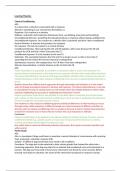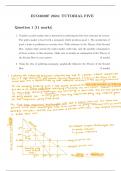WHAT IS A PARADIGM
What is a “Paradigm”?
Thomas Kuhn:The Structure of Scientific Revolutions (1962) coined “”paradigm”
Since does not necessarily form as a linear progression to accumulate knowledge
o But it is marked by significant shifts up and down
Paradigm: An ‘intellectual tradition’ which has (unspoken) elements including
o A set of theoretical assumptions on how the world works
o Limits and expectations concerning the kinds of questions that can be asked
o Accepted methods of investigation and standards of evidence
Normal science anomalies (phenomena that do not fit a paradigm) crisis (accumulation of anomalies) revolutions
(new thinking, innovaiton, scientific seeking) new paradigms
Paradigms in Violence and Security
Intellectual traditions with an understanding of
(1) Core elements like
o Human nature
o The nature & role of the state
o The drivers of conflict
o The nature of threats
o The conditions for peace
o Example: Rationalism:
(2) Research methods and standards like
o The scope of the research field (what belong to it)
o The nature of enquiry and appropriate methods (what methodlogy do we use to study the worlf)
Paradigms are historically embedded and shaped
WHAT IS/COUNTS AS POLITICAL VIOLENCE (AMOORE AND DE GOEDE ARTICLE 2008)
Core definition
Political Violence marked by (Krause, p. 118)
o Degree and scale of organization: collective
o Meaning and motivation of purpose (intention behind violence): goals and behavior modification of others
o Nature of the act: physical harm, destruction death (other types of act might be included depending on the way
we think about violence)
Two types of violence:
1) The overt and visible drone attacks on the Afghanistan-Pakistan border
2) The much less readily visible violence of targeting the financial transactions of aid agencies, such that the West failed to
deliver sufficient aid to those affected by the severe flooding in that same region in 2010.
Drone targeting in Pakistan
Amid widespread political consensus that the Afghanistan-Pakistan borderlands represent the spatial origins of future
terrorist violence in the West, the US began to develop its own response – the targeted killing of militants in the AfPak
region using unmanned aerial vehicles (UAVs) or ‘drones’.
1
, For the state to exercise what sociologist Max Weber termed ‘the monopoly of the legitimate use of physical violence’ the
future terrorist violence of northern Pakistan has to be understood in a particular way.
o An unconventional violence, which goes beyond known frameworks of political objectives, could only be met with
a non-standard response, beyond conventional limits of legitimate force
o The legitimate right of a state to exercise violence in self-defense (an open-ended interpretation of selfe defense)
Financial targeting in Pakistan
For a number of years, global financial authorities have expressed increasing concern over Pakistan’s position in the global fight
against money laundering and terrorism financing. In the global pursuit of dirty money, states have to adhere by a set of rules and
recommendations developed by the Paris-based Financial Action Task Force (FATF), and OECD (Organization for Economic Co-
Operation and Development) platform erected in 1989 to foster international cooperation against money laundering.
The FATF
Since 9/11, charged with an agenda designed to cut off terrorists’ access to financial resources and global banking systems.
Nine special recommendations on Terrorist Financing (e.g. criminalization in national law of financing of terrorism, freezing
and confiscating accounts, examine transactions, etc.)
The demands FATF places on countries are far reaching, especially if those countries have an underdeveloped banking
sector that relies partly informal money transfer networks)
o Countries which do not adhere to these recommendations may receive criticism and negative evaluations in the
regular country reports that the FATF produces, which might affect their credit rating and access to international
capital markets
FATF had identified Pakistan as a jurisdiction with strategic deficiencies it its anti-money laundering and anti-terrorism
financing regulatory structures
The global community did not only target Pakistani territory militarily through drone strikes but also by demanding banking
reform and changes in national policing practice against suspect monies.
Twin targetings in Pakistan
If drone targeting leads to visible violence, death and collateral damage, financial targeting seems completely different: it works
through high-level diplomacy, legal reform and the proscription or outlawing of certain organizations.
Ways in which drone strikes and financial targeting may both have violent effects, and how they are interwoven in their political
logics:
(1) The way in which financial sanctions work and the effects that they may have on charity organizations
Charitable organizations have to demonstrate that they do not work together or otherwise associate with organizations
that are suspected of supporting terrorists.
o But these guidelines raise a number of questions concerning the legitimacy of charitable work.
To navigate these requirements, charities have to keep detailed records of their employees and beneficiaries, which
requires, for example, the collection and storage of local personnel’s CVs, birth certificates and other official documents and
explaining gaps in their CVs. Such demands are considered even unrealistic
(2) The seemingly less violent practices make it more difficult in cases of humanitarian emergency to deliver aid on the ground.
On the one hand, the UN urgently appealed for help (for the Pakistani flood victims in 2010) in August 2010 in the face of
unprecedented suffering and damaged caused by severe floods in large parts of Pakistan.
However, these public calls for action and donations obscured the political contestations over how aid was to be delivered
to the people on the ground
o One of the key questions was in terms of how to prevent militant Muslim groups in fragile northwest, where the
worst flooding has occurred from distributing their own aid and turn traumatized refugees against the government
and the U.S.
2
, The representation of Pakistan as a place both risky and at risk had constraining effects on the response of the rest of the
world
(3) They both operate through logics of precision targeting and new ways of governing in the so-called untruly spaces that have
come to typify contemporary warfare.
These logics of precision-targeting support specific interventions inside the sovereign space of another country without a
formal declaration of war. Risk-based targeted governing becomes the new face of contemporary conflict
o And the less overt and scarcely visible violence of stopping money and backlisting a country is making its people
more vulnerable to the more overt forms of visible violence manifested in drone attacks.
The relationship between violence and power
The example of the twin targeting of drone attacks and financial measures in Pakistan shows two things that are of more general
importance for the study of violence and modern warfare:
1. It shows how difficult it is to distinguish between war and non-war, combatant and non-combatant, particularly when
modern wars are fought not against clearly locatable and identifiable enemies, but against dispersed enemy networks,
which are intermingled with normal populations and urbans environments.
2. It shows that it is not always easy to recognize violence: although we think we know it when we see it, political measures
that are pursues through diplomacy and international dialogue can still have violent implications and effects on the ground.
Collective violence (Charles Tilly 2003)
Tilly 1990 argues that war is a fundamental strategy of state-making and that states and state agents are often the primary
perpetrators of violence.
Seeks to understand the nature of collective violence, Tilly argues that they have common characteristics that go to the heart of the
nature of violence as an ‘episodic social interaction’.
Shared characteristics
1) They inflict ‘physical damage on persons and/or objects’
2) They involve ‘at least two perpetrators’
3) They result at least to some extent from ‘coordination among persons who perform the damaging acts’.
Based on the identification of these elements, he emphasizes the increasingly irregular and differentiated nature of modern
warfare, marked not by clearly demarcated battles between states, but by violent (terrorist) resistance, civil war and civilian
involvement.
When politics become violent
David Campbell shows that dehumanization discourses play a key role:
“I understand now that nothing but “otherness” killed Jews, and it began by naming them, by reducing them to the other.”
“Then…everything became possible.”
Understood this way, particular representational practices and social discourses are themselves violent
Violence is not defined only through physical force or injury, but through the power that renders othering possible and that
creates the conditions of possibility for war or torture.
Core Puzzle: visible and invisible violence
Is political violence always:
o Visible, concrete, act of physical hurt?
o Violence as means (in pursuit of a clear end)?
3
, o “For his, what comes to count as violence in global politics is that which makes a visible tear in the fabric of daily
life – the act of terrorism, the loss of life on the city street – the subjective violence with its identifiable subjects
and human agents, its ‘evil individuals’.”
Or can political violence also be:
o Invisible, indirect?
o Without clear agenda or clear perpetrators?
What is labelled ‘violence is itself highly normative, it has changed over time” (p. 472) Bourke
Who are the perpetrators?
o “for we are so obsessed and distracted by the spectacular forms of violence (the killing, war, rape), that we fail to
address the much less visible, but massively destructive force of structural violence that lies underneath (people
dying from lack of health care, malnutrition, slavery).”
“The obvious signals of violence, acts of crime and terror, we should disentangle ourselves from these signals, in order to
see better how violence pervades normality itself, and how everyday life contains within it objective violence.”
SOME KEY THINKERS ON POLITICAL VIOLENCE (OFFER DIFFERENT ANSWERS TO THE CORE PUZZLE)
(1) KEITH KRAUSE: FROM ARMED CONFLICT TO POLITICAL VIOLENCE (2016)
Keith Krause: contemporary thinker ETH Geneve, Programme Director of the Small Arms Survey
We usually study violence within the war context
But, war-related political violence is important but gives limited picture:
o Most contemporary lethal violence does not occur in conflict zones, the majority of states most affected by lethal
violence are not at war, and the levels of lethal violence in many non-conflict settings are higher than in war zones.
o Much of this non-war violence is organized, not random, and political in nature.
An exclusive focus on war means we know little about how we get from such things as state repression of group violence to civil
war and what the consequences might be for international and regional order.
A narrow focus on wars and formal armed conflicts thus obscures the high levels of everyday violence and insecurity around
the world.
It limits the scope of debate on moral and legal responsibility to forms of violence covered by just war principles and
international humanitarian law, while obscuring the morally equivalent responsibility that governments should face for
other forms of violence and harm committed in their name.
Should define Political Violence as: including violence for explicitly political ends, or that directly undermines and challenges
the state’s legal monopoly over the legitimate use of force, or that implicates the state and its repressive apparatus.
Four facts about contemporary violence
1) Most lethal violence does not occur in conflict zones
2) The majority of states most affected by lethal violence are not at war
3) The levels of lethal violence in some non-conflict settings are higher than in war zones
4) Much of this violence – but we do not know how much, is organized, non-random, and in some sense political
Looking at numbers
How do we count war deaths in Iraq of 2006? (p. 117)
o 3931: battle-related
o 5840 – 7028: indirect battle related (i.e. roadside bombs) Not a clear perpetrator, many factions might be
fighting, or mines were just left by retreating troops
4










